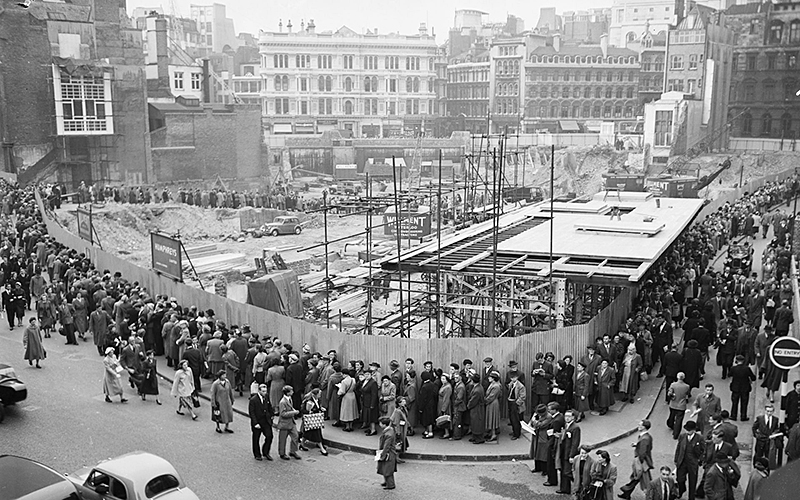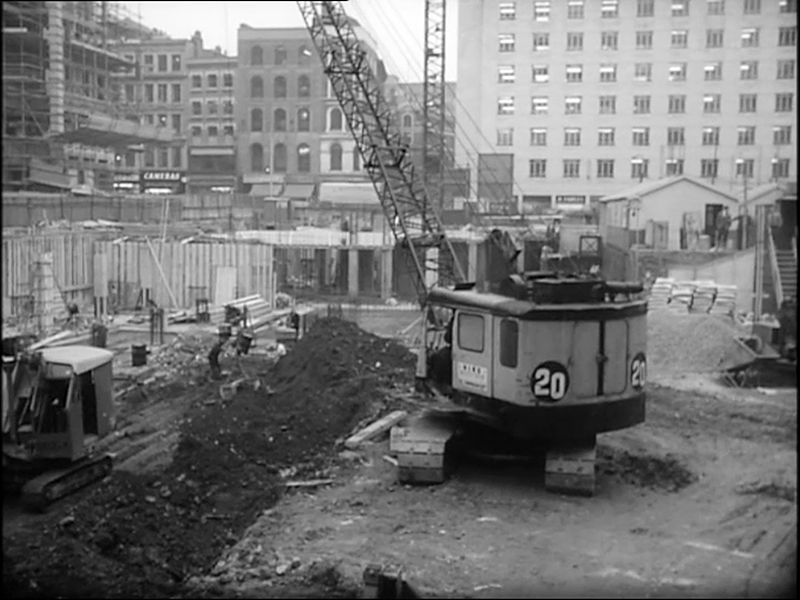Quatermass and the Mithraeum
Posted by weavingsandunpickings on September 2, 2018
The BBC recently put the original 1958-59 TV serial of Quatermass and the Pit on iPlayer, so I grabbed the chance and watched it. I’ve seen the Hammer version so I knew the story, which is much the same here as in the film. But, obviously, the six-episode format here gave them more space to develop the characters and settings, and just to play things a little slower. I was quite surprised by how high the production values were for a piece of television made in the late 1950s. This is all well covered on the Wikipedia page, and included the use of film (rather than video) as a default format, a mixture of live and pre-recorded footage, at least two studio sets and really quite extensive special effects. All this before Doctor Who even existed, but the influence of Quatermass on both the general characterisation of the Doctor and some particular stories has been widely noted.
According to Wikipedia, Nigel Kneale wrote this story in part as an allegory for and critique of contemporary racism, and the last episode in particular certainly does contain plenty of dialogue about how the urge to attack those different from ourselves is in all of us and needs to be controlled. There seem to have been some genuine efforts (by the standards of the time) to put together a diverse cast of characters as well. There is one (1) black construction worker at the beginning, who speaks with the same “I have Caribbean origins but also learnt RP at drama school” accent as Don Warrington in Rising Damp. There is also the Canadian archaeologist, Roney, an Irish newspaper editor (played by Actually Irish actor Tony Quinn, not somebody doing paddywhackery), several working class characters and a non-zero smattering of professional women (though never in leadership roles, just as the only black guy is a labourer).

Some sense of international ramifications is of course important to the story Kneale is trying to tell. It has to be about the impact which the Martians have had on the whole human race, not just London, and I think that is why we also get the scene of two American pilots reporting to a newsroom back home on the strange phenomena they are witnessing over London. But amongst it all, we still have Barbara, the most prominent female character in the story, proving to be the most ‘susceptible’ to alien influences, which is exactly the same trope (women as all about emotions and sensitivities) that annoyed me so much when I watched Kneale’s The Stone Tape that I couldn’t really enjoy the rest of the story. It’s not as bad here, because it’s nothing like as central to the plot, but it still made me grimace. It also didn’t entirely make sense to me that Martians would have conducted a race purge on their home planet to remove all forms of mutation, and yet also seek to colonise the Earth by genetically splicing their intellects and values into primates. Surely only survival in a pure form would do for them?
One of the few significant differences between the TV serial and the later Hammer film is that in the Hammer film the Martian capsule is discovered during work on the London Underground, but in the TV serial it emerges during construction work in Knightsbridge (though Quatermass does discover evidence of disturbances in the same area when the local Underground line was built in 1927). I’m not sure why the change was made for the Hammer film, but I did quickly realise as I watched that the original setting as conceived for the TV series carried some very specific and significant connotations indeed. This is mainly thanks to the recent coverage of the re-siting and re-opening of the London Mithraeum, which has meant in turn that pictures of its original discovery and excavation in 1954 have been floating around the internet. Well, whaddaya know? It turns out that the plot and design of this story, written just a few years later, were quite clearly directly inspired by the discovery of the Mithraeum. It is actually alluded to very early on in the dialogue, when the construction workers are wondering what to do about the skull they have found, and deliver the following exchange:
WORKER 1: Reckon we ought to report it? You know – to a museum or something?
WORKER 2: That’s right – like them Roman remains.
I’m pretty sure most viewers would have thought of the Mithraeum site straight away on hearing that dialogue, and that Kneale intended them to, but much more ample confirmation of the link between the two comes from the design of the sets. Have a look first at these pictures of the actual Mithraeum excavation:


Visitors on the Temple of Mithras excavation site , Walbrook London, 1954
Some particular characteristics to note here include: a construction site surrounded by hoardings in central London, signs painted with block letters indicating the name of the development and construction company, access via a ramp, shorings holding up the edges of the site, a construction workers’ hut (again with the name of the company on it in block letters) and of course queues of people who have come to see the finds. Now check out how every single one of those features is faithfully replicated in Quatermass and the Pit:








See what I mean? There’s no way that is coincidental – although oddly I can’t seem to find anyone else around the internet who has pointed it out before. And the connection matters for our reading of Kneale’s story. If his capsule full of Martians is in part inspired by the Mithraeum, then his tale of Martian colonisation inevitably acquires Roman resonances. Indeed, it does draw very nicely on the long-established narrative of the Romans as aliens from a brutal, martial society who came to Britain, changed us fundamentally and then left again. There’s also a long history of seeing Mithraism as a diabolical counterpart to and rival of Christianity which nicely underpins the idea that the Martians are at the roots of folk beliefs about the Devil in Quatermass and the Pit – the witch-marks in the capsule (for some reason called ‘pentacles’ in the dialogue, even though they clearly aren’t), the horned figure, the way it can be defeated with iron. All in all, in fact, there’s a pretty good case for saying that the story of Quatermass and the Pit is an imaginative re-working of the discovery of the London Mithraeum, with the Romans re-cast as Martians. And as both a Romanist and a cult TV fan, that gets a big thumbs-up from me.


Blogs of the Year 2018 | Sphinx said
[…] Penelope Goodnan on Quatermass and the Mitheaeum; Peter Gainsford on the citation problem in that terrible article on social networks in […]